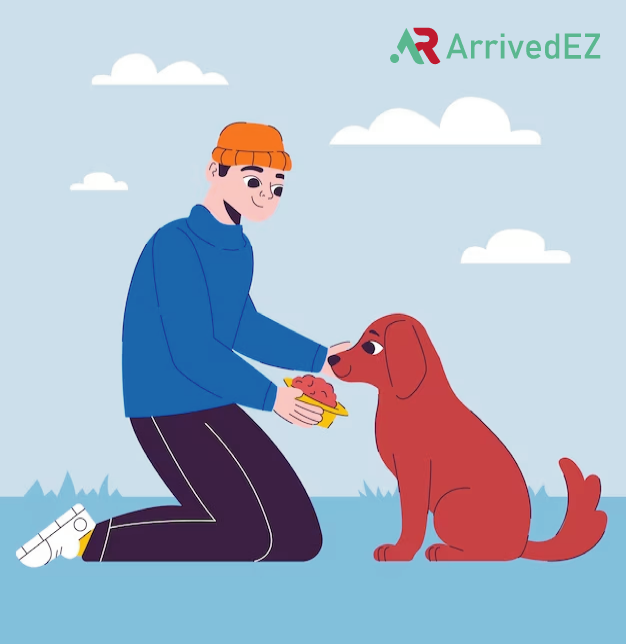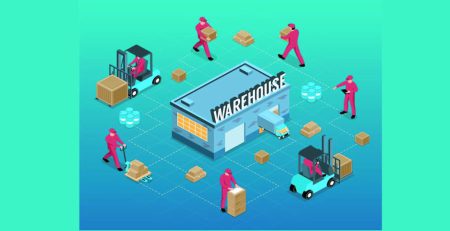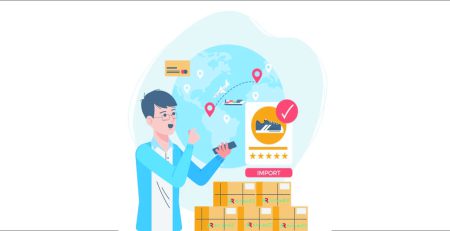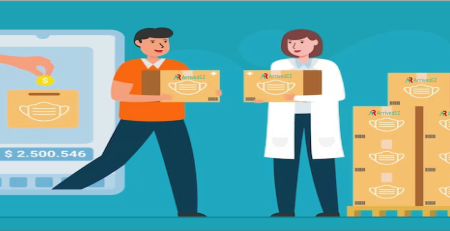Eco-Paws: Analyzing the Environmental Impact of Instant Dog Food Delivery
Arrived EZ2024-01-16T14:00:15+00:00Alright, let’s dive right in! When we think about instant dog food delivery, it’s like a dream come true for pet owners, right? You click a button, and voilà, Fido’s food is at your doorstep. But hang on a second—have you ever stopped to think about what this convenience means for our planet? That’s what we’re unpacking today in “Eco-Paws” – a deep dive into the environmental impact of instant dog food delivery.
deep dive into the environmental impact of instant dog food delivery.
First off, let’s chat about the carbon pawprint. You know, like a carbon footprint, but for our four-legged friends. Every time a delivery van zooms to your house, it’s burning fuel and emitting CO2. It’s like each bag of dog food comes with a little invisible cloud of greenhouse gases. And with more people opting for home delivery, those emissions add up. But wait, it’s not all doom and gloom. Some companies are switching to electric vehicles, which is like giving Mother Nature a high five.

Now, onto packaging—the necessary evil of the delivery world. Picture this: a bag of dog food wrapped in layers of plastic, cozied up in a cardboard box, swimming in a sea of packing peanuts. It’s a bit much, isn’t it? This packaging may protect the food, but it’s a headache for the environment. Most of it ends up in landfills, taking ages to break down. The silver lining? More companies are waking up and smelling the coffee—or, should we say, the kibble? They’re turning to recyclable or compostable materials, which is a step in the right direction.
Let’s not forget about the food itself. The production of dog food, especially meat-based varieties, has its own set of environmental impacts. It takes a lot of resources—water, land, and energy—to produce that chicken or beef for Fido’s dinner. And just like with human food, there’s the issue of food waste. Sometimes, our furry friends turn up their noses at dinner, and into the bin it goes. It’s a tricky problem, but some brands are tackling it by offering customizable meal plans to reduce waste.
But hey, it’s not all about pointing fingers. As pet owners, we’ve got a role to play too. We can make eco-friendly choices, like picking sustainable dog food brands or opting for local delivery services that have a smaller carbon footprint. And how about this idea: combining orders with other pet owners in the neighborhood? It’s like carpooling for dog food—fewer trips, less emissions.
Convenience and Time savings
First up, the most obvious impact: convenience. Instant dog food delivery is like a godsend for busy pet parents. It’s a no-brainer, really. You’re swamped with work, errands, and maybe a social life (if you’re lucky), and then there’s this service that magically brings dog food to your doorstep. This saves time and hassle, and let’s be honest, it’s a relief not to lug heavy bags of kibble from the store.
The Era of Instant Gratification
We’re living in an age where instant gratification isn’t just a luxury; it’s almost expected. Think about it: with a few taps on a smartphone, you can order food, book a ride, or even find a date. This shift towards immediate fulfillment has reshaped our perception of time and efficiency. We’re so used to quick services that waiting more than a few minutes for a coffee can throw off our entire morning!
Impact on Daily Life
The convenience of modern services has a domino effect on various aspects of our daily life. Online shopping, for instance, saves us a trip to the store. Home automation systems let us control our environment without lifting a finger. Even banking can be done from the comfort of our couches. This shift not only saves time but also reduces the mental load of juggling multiple tasks. It’s like having an invisible assistant help us through our day.
Work-Life Balance
Now, here’s a biggie. The time saved through convenient services can significantly impact our work-life balance. In theory, with less time spent on mundane tasks, we have more hours to relax, pursue hobbies, or spend with family and friends. However, it’s not always that straightforward. Sometimes, the time we save gets swallowed up by even more work, blurring the lines between our professional and personal lives.
The Downside of Over-Reliance
It’s not all sunshine and rainbows, though. Relying too heavily on convenient services can lead to a decrease in basic life skills. Think about it: if you’re always ordering takeout, when do you cook? If you always use GPS, do you actually know how to read a map? There’s a risk of losing touch with these fundamental skills in our pursuit of convenience.
Environmental and Social Impacts
Moreover, we can’t ignore the broader impacts. The convenience of online shopping, for instance, means more delivery vehicles on the road, contributing to traffic congestion and pollution. And while we’re saving time personally, the pressure is often transferred to workers in these service industries, who face demanding schedules to meet our need for speed.

Economic Impact
Now, let’s talk dollars and cents. This industry is booming, and it’s churning the wheels of the economy. Jobs are being created, from those working in the warehouses packing the food to the drivers dashing from door to door. But there’s a flip side. Local pet stores might feel the pinch as more people shift to online ordering. It’s a classic tale of convenience versus community.
Direct and Indirect Impacts
The economic impact can be direct or indirect. Direct impacts are easily observable and quantifiable, like the creation of jobs due to a new factory opening. Indirect impacts, on the other hand, are the ripple effects of these direct impacts. For example, the new factory might boost local businesses that supply materials or cater to the increased workforce.
Job Creation and Unemployment
A central aspect of economic impact is its effect on employment. Positive economic growth typically leads to job creation, reducing unemployment, and improving living standards. However, economic downturns or shifts in industry trends can lead to job losses, with far-reaching effects on communities and even entire regions.
Consumer Spending and Confidence
Consumer spending is the lifeblood of the economy. When people feel confident about their financial situation, they tend to spend more, fueling economic growth. This confidence is often linked to job security, wage growth, and overall economic conditions. Conversely, when consumer confidence drops, spending decreases, which can slow down the economy.
Business Investment and Growth
Businesses play a crucial role in economic impact. When businesses invest in new projects, technology, or expansion, it can lead to job creation and economic growth. Government policies, such as tax incentives or interest rate adjustments, can influence business investments significantly. However, if businesses face uncertainty or unfavorable conditions, they may hold back on investments, which can dampen economic prospects.
Global Trade and Market Dynamics
In our interconnected world, global trade and market dynamics are vital components of economic impact. Trade agreements, tariffs, and international relations can have profound effects on economies. For example, opening up trade can lead to a surge in exports, benefiting industries and workers, but it can also increase competition for domestic producers.
Socioeconomic Effects
Lastly, the economic impact extends beyond mere numbers. It has profound socioeconomic implications. Economic growth can lead to improved public services, better healthcare, and education, thus improving quality of life. On the flip side, economic struggles can exacerbate issues like inequality, poverty, and social unrest.
Environmental Considerations
Here’s where it gets a bit thorny. Every delivery truck on the road means emissions—those pesky CO2 that’s heating up the planet. And then there’s the packaging. Most dog food comes in plastic bags, and we haven’t even started on the cardboard boxes and protective packaging for delivery. However, it’s not all doom and gloom. Some companies are switching to eco-friendly packaging and electric or hybrid delivery vehicles, which is a breath of fresh air.
Climate Change and Global Warming
At the forefront of environmental considerations is the issue of climate change and global warming. Triggered mainly by human activities, notably the burning of fossil fuels and deforestation, these phenomena are leading to rising global temperatures, melting ice caps, and erratic weather patterns. The consequences are profound, affecting not just the environment but also economies, health, and social structures.

Pollution and Waste Management
Pollution, in its many forms, poses a significant threat to the environment. Air pollution from industries and vehicles, water pollution from chemicals and waste, and soil contamination are just some examples. Waste management is also a critical aspect, as the increasing amount of waste generated by our consumerist lifestyle strains landfills and leads to issues like plastic pollution in oceans.
Biodiversity and Ecosystem Preservation
Biodiversity—the variety of life on Earth—is under threat due to human activities. Habitat destruction, pollution, climate change, and the introduction of invasive species are leading to a dramatic loss of species and the degradation of ecosystems. Preserving these ecosystems is not just about protecting wildlife; it’s about maintaining the natural balance that supports all life, including humans.
Natural Resource Management
Our planet’s resources—water, soil, forests, minerals – are finite. How we manage these resources is a critical environmental consideration. Overexploitation and unsustainable practices lead to depletion and degradation of these resources, compromising their availability for future generations. Sustainable management practices are crucial to ensure that we meet our current needs without compromising the ability of future generations to meet theirs.
Renewable Energy and Sustainable Technologies
Transitioning to renewable energy sources like solar, wind, and hydroelectric power is essential in mitigating climate change and reducing our dependency on fossil fuels. Similarly, developing sustainable technologies in areas like agriculture, manufacturing, and transportation is crucial for reducing our ecological footprint.
Environmental Policies and Legislation
Government policies and international agreements play a vital role in addressing environmental issues. Legislation aimed at reducing emissions, protecting endangered species, managing natural resources, and promoting sustainability is crucial. International cooperation is also essential, as environmental issues know no borders.
Individual Responsibility and Collective Action
Finally, environmental considerations are not just the responsibility of governments and corporations; individual actions matter too. Simple choices like reducing waste, conserving water, using public transport, and supporting sustainable products and practices can collectively make a significant impact.

Impact on Pet Health
Now, let’s wag our tails to another angle – pet health. With instant delivery, there’s a wider variety of dog foods available, including specialty and health-focused diets. It’s like a buffet of choices for your pooch, which can lead to better health and nutrition. But, and it’s a big but, there’s also the risk of overfeeding and not monitoring your dog’s diet closely. Convenience can sometimes lead to complacency.
Nutrition and Diet
The cornerstone of pet health is proper nutrition. Just like humans, pets require a balanced diet that meets their specific nutritional needs. This can vary based on the pet’s age, breed, size, and activity level. The rise in pet food options, including specialized diets for allergies, weight management, and age-related issues, reflects the growing awareness of the importance of proper nutrition in pets. However, there’s also the risk of overfeeding and malnutrition, either through a lack of understanding or due to the pet owner’s own dietary beliefs, like imposing a vegan diet on naturally carnivorous animals.
Exercise and Physical Activity
Physical activity is just as important for pets as it is for their human counterparts. Regular exercise helps maintain a healthy weight, improves cardiovascular health, and strengthens muscles and joints. It also plays a critical role in mental stimulation and behavioral management, especially
Mental Health and Enrichment
Pet mental health is an area that’s gaining more attention. Pets can suffer from anxiety, stress, and boredom, particularly in environments with little stimulation or in situations of neglect. Ensuring pets have a stimulating environment, with toys, playtime, and interaction, is vital for their mental well-being. This aspect of pet health is especially important in urban settings where pets may have limited space and opportunities for natural behaviors.
Preventive Healthcare and Veterinary Care
Regular veterinary care is vital for maintaining pet health. This includes routine check-ups, vaccinations, parasite control, and dental care. Early detection and prevention of diseases can significantly enhance the quality and length of pets’ lives. The rise in pet insurance and wellness plans reflects the growing emphasis on preventive healthcare for pets.
Genetic and Breed-Specific Issues
Certain breeds are predisposed to specific health conditions, such as hip dysplasia in large dog breeds or respiratory issues in flat-faced cat breeds. Awareness of these genetic predispositions is important for their early detection and management. Responsible breeding practices and genetic screening can help reduce the incidence of these hereditary conditions.
Environmental Factors
The environment a pet lives in plays a significant role in its health. Exposure to harmful substances, extreme weather conditions, and inadequate living conditions can all negatively impact pet health. Additionally, the rise in environmental pollutants and chemicals has raised concerns about their effects on pet health, mirroring similar concerns in human health.
Human-Pet Bond and Emotional Health
Lastly, the emotional bond between pets and their owners has a profound impact on pet health. Pets that are well-loved and integrated into the family tend to be healthier and happier. This bond has mutual benefits, as the emotional connection with pets has been shown to improve the mental and physical health of the owners as well.
Social and Lifestyle Changes
Finally, let’s ponder the social aspect. Instant dog food delivery is a marker of how our lifestyles are evolving. We’re leaning more towards services that offer convenience and efficiency. It’s part of a broader trend where we expect things at the tap of a button, be it food, entertainment, or even dog food. This shift is changing how we interact with our local communities and businesses.
In conclusion
The journey of instant dog food delivery from a click to a bark at the door is more complex than it seems when we consider its environmental footprint. It’s a bit of a tightrope walk, balancing convenience with our responsibility to the planet. But the good news is that both companies and consumers are starting to step up, making choices that are better for the earth. By being mindful about how our furry friends’ meals are produced, delivered, and packaged, we can all contribute to a greener, happier world. And let’s face it, that’s something to wag our tails about!
So next time you’re about to order Fido’s dinner with a simple click, remember the impact it has beyond your doorstep. Every small decision can make a big difference. Who knew that being a pet owner could also mean being an eco-warrior? Now, that’s something to chew on.












Leave a Reply